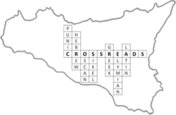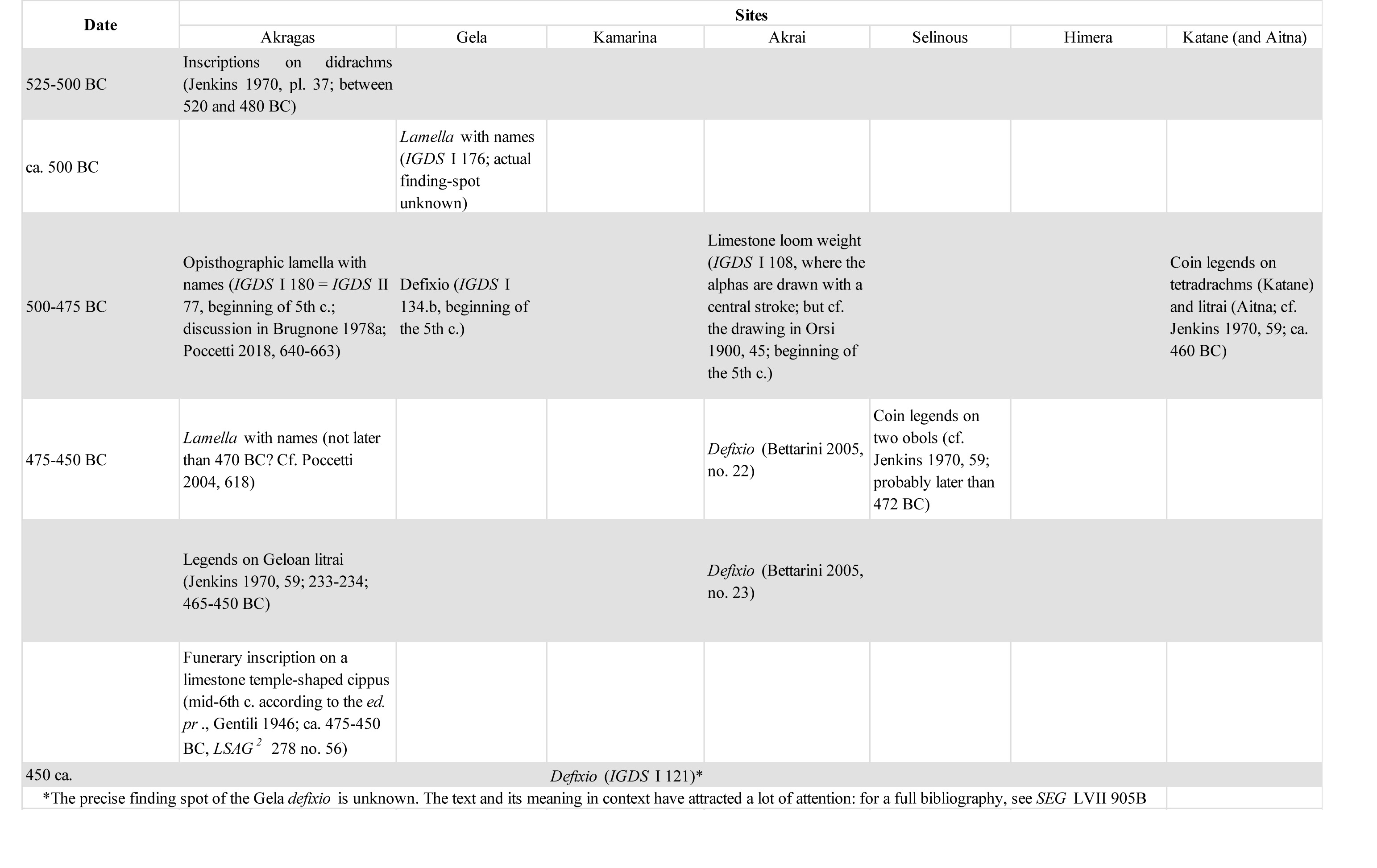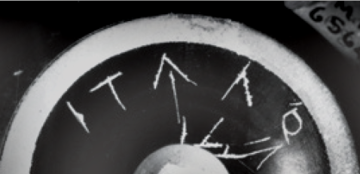Researching the writing systems of ancient Sicily
About the arrow-shaped Alpha and Sikel identity
The epigraphic landscape of archaic Sicily is linguistically quite diverse (see my previous post) and a relatively large part of the material found relating to this period (around three quarters of the total) consists of inscriptions in languages other than Greek that are rendered in Greek alphabets (fig. 1). Out of a total of about 1300 inscriptions found in the time stretching between the end of the 8th and the half of the 5th century BCE about 440 documents are in the 'Elymian' language, spoken by the populations that inhabited the north-western area of Sicily, while about 280 documents are in different varieties of a language marked by Italic traits and spoken in the eastern and central-southern area of the island, referred to as 'Sikel' on the basis of a subdivision of the pre-Roman peoples of Sicily inherited from the literary sources.
The Sikels supposedly arrived on the island from Italy three hundred years before the Greeks, according to Thucydides (6.2.4). They came into conflict with the Sikans, who had settled there previously, and drove them out of the eastern and southern area, which was then called Σικελία and lost its previous name, Σικανία (the question of the identification of Sikels and Sikan in the sources is summarised very clearly by Paolo Poccetti, 2012). We do not have sufficient data to substantiate the interpretation of the sources according to which Sikans and Sikels were different peoples of different origins: neither the material nor the epigraphic culture - the latter apparently absent in the case of Sikans - are distinctive enough to give us conclusive evidence. Moreover, the elements in the sources do not always provide consistent data to identify these populations. Thus, for example, an Akkadian Babylonian text from Ugarit of the 12th century speaks of ši-ka-la-iu-ú referring to a population of skilled navigators that could have been the Sicilians; a reference to Sikels could be seen in the Egyptian škrš; and the Homeric Σικανίη (Od. 24.307) and the Herodorean Σικελία (Hdt. 7.170) are both used to identify the whole island, not a particular population.
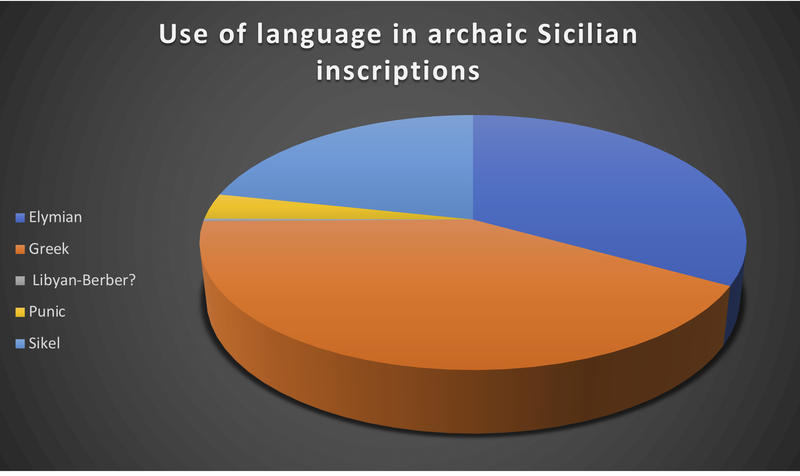
Fig. 1. Use of language in Sicilian archaic inscriptions (700-480 BCE).
The examples could be multiplied but would not help to clarify the overall picture. Scholarship has consequently maintained the division by the literary sources into Sikels, Sikans and Elymians in the ethno-geographical landscape of the island (Thuc. 6.2.5; Dion. Hal. 1.22.3-5; Diod. Sic. 5.2-3), allowing for the possibility that the Sikans did not adopt writing, unlike the Sikels and Elymians, and had a material culture that was not distinct from that of Sikels. The most likely hypothesis is that Sikels and Sikans were kindred peoples (or the same people) and that during the Middle and Late Bronze Age, while the Sikels came into contact with the peninsular peoples, opening up to a new culture and partly modifying their own, the Sikans, settled in the more distant central areas and maintained Middle Bronze Age traditions, marked by links with the Aegean culture (Albanese Procelli, 2003, 18-19; but see also Jonathan Prag's 2020 recent proposal for a reading on the issue).
An epigraphic-linguistic specificity seems to characterise the Sikels, endowed with linguistic varieties characterised by the absence, almost everywhere, of aspirated consonants and aspirations and by the use of a particular type of alpha, realised in two main variants, the first with a stroke attached to the vertex (fig. 2) and the second with a detached stroke (fig. 3), whose dissemination is found only in the Sikel area. In addition to linguistic variety, there is some variety of epigraphic usage, mainly determined by the influence of the nearest town or towns with which these communities had more contact. Several micro-regions have been identified on the basis of epigraphic habits (Agostiniani, 1992, 130-132):
-
the Etna region (fig. 4), with the sites of Mendolito di Adrano, Centuripe, Poira, Paternò-Civita, Paliké-Rocchicella di Mineo, Montagna di Ramacca that followed the uses of Katana and/or Naxos and/or Leontinoi;
-
the Hyblaean area (fig. 5), with the sites of Licodia Eubea, Sciri Sottano (10km south-west of Licodia Eubea), Monte Casasìa, Castiglione di Ragusa, Terravecchia di Grammichele, Morgantina, probably in contact with Syracuse and sub-colonies (Akrai, Kasmenai and Kamarina), and to a lesser extent with Gela;
-
central Sicily (fig. 6), with the sites of Montagna di Marzo and Terravecchia di Cuti, which seem to refer to the epigraphic tradition of Gela.
The sign of the arrow-shaped alpha ('alpha siculum', Ribezzo, 1913, 374) occurs widely in many of the Sicilian centres in question, although not uniformly (some villages adopted the 'normal' alpha with the horizontal bar in the centre, see fig. 7). The term 'alpha siculum', initially used by scholars in a purely descriptive manner, over time and, above all, following the interpretation provided by Luciano Agostiniani (cf. e.g. Agostiniani, 2012) has taken on a different meaning, which has led to seeing this alpha as an 'identity marker'. Due to its dissemination/distribution almost exclusively in the Sikel area, it has been hypothesised that the use of this particular type of alpha was linked to the Sikels' intention to mark their inscriptions in an identity-oriented way, according to a socio-anthropological model defined as 'antagonistic acculturation' (Cardona, 1981), which would lead a group/people to adopt customs deliberately in contrast to those of the dominant group. This hypothesis has remained the most plausible (and the most appealing) to account for the existence of the particular ductus of the letter.


However, before concluding that there were identity reasons behind this epigraphic practice, we should ask ourselves whether this alpha was indeed so aberrant (or atypical) in the Greek epigraphy of the island as to be considered a Sikel marker through and through. As Olga Tribulato has clearly shown (Tribulato and Mignosa, 2021: 315-318), the arrow-shaped alpha occurs in Greek epigraphy on the island, particularly in several texts inscribed on metal (fig. 8), whether this variant arose from purely technical needs or became a variant specifically used in metal texts. The arrow-shaped alpha, widespread in different areas of the island, may have been adopted by the workshops at Sikel centres that were in contact with the poleis where it was used and then reiterated in the Sikel centres as the 'preferred' type. Its dissemination would therefore depend on the communication and exchange routes of the area (ibid.: 310-315).
What is more, we know from the Greeks of the existence of the 'Sikel' people. The epigraphic (including a famous and fragmentary treaty between Athens and some Western Greek poleis, IG I3 291) and literary documents that speak of the peoples of the eastern area as a single people are in fact written by the Greeks and therefore describe, rather than a historically existing cultural-identity cohesion, the Greek perspective on these peoples. As Amselle, 1993 (and European colonisation studies) have shown, ethnonyms do not always reflect the historical reality of a place when they are heteronyms, i.e. ethnonyms given by other peoples. Instead, they simply have a 'performative' nature (ibid.: 17), which means that they are created and used exclusively as 'meanings' (not signifiers) to indicate a particular social group by another external group. We are therefore, once again, faced with an interpretive gap in which our reading of the facts takes place through the Greeks' narrative, which is in turn mediated by our own over-interpretations focused on identity.
But there is more. The island's epigraphic culture, that of the local populations, was born at the end of a much more complex historical process than we have yet been able to understand, which is that of coexistence and exchange, of mutual adaptation and readjustment between the various groups present on the island in the aftermath of their arrival (the epigraphic evidence in the indigenous languages begins in 600 and ends around 480 BCE). When we see the Sikels adopting writing, or certain iconographic types typical of the Greeks - using a very controversial word that I use here provocatively, 'Hellenising' - we are only observing the end of a process, a phase in which all these peoples in contact with the Greeks developed practices and customs influenced by the Greeks and which tended to be more uniform among themselves.
The answer to this interpretive gap is not to take refuge in apparently 'solid' heuristic categories such as Hellenisation (and the many similar ones such as Acculturation, Hybridity, Middle Ground etc.), or to take up Greek literary sources in search of new readings. The answer is to try to reconstruct the history of the island’s inhabitants preceding the arrival of the Greeks with greater socio-historical precision and only then to delve into the 8th-5th centuries BCE in order to assess the epigraphic phenomena that characterise these populations and, therefore, trace the dynamics of the adoption of writing and epigraphic habitus over the long term. I very much hope we will be able to do this soon!
Indagando i sistemi di scrittura della Sicilia antica.
Dell’alfa ‘a freccia’ e dell’identità Sicula
Il panorama epigrafico della Sicilia arcaica è molto vario dal punto di vista linguistico (vd. il mio precedente post) e una parte relativamente ampia del materiale rinvenuto relativo a questo periodo, circa tre quarti del totale, è costituito da iscrizioni in lingua diversa dal greco ma in alfabeti greci (fig. 1). Su un totale di circa 1300 iscrizioni rinvenute nel periodo compreso tra la fine dell’VIII e la metà del V a.C., ben 440 documenti circa sono in lingua ‘elima’, parlata dalle popolazioni che abitavano l’area nord occidentale della Sicilia, mentre circa 280 sono in diverse varietà di una lingua, connotata da tratti italici e parlata nell’area orientale e centro-meridionale dell’isola, che usiamo definire ‘sicula’ sulla base di una suddivisione delle popolazioni della Sicilia prima della colonizzazione ereditata dalle fonti letterarie. I Siculi sarebbero arrivati nell’isola dall’Italìa trecento anni prima dei Greci, stando a Tucidide (6.2.4). Entrati in conflitto con i Sicani, lì stanziati, avrebbero prevalso scacciandoli dall’area orientale e meridionale che avrebbe preso da allora il nome di Σικελία perdendo la precedente connotazione di Σικανία (la questione dell’identificazione di Siculi e Sicani nelle fonti è sintetizzata molto chiaramente da Paolo Poccetti, 2012). Non abbiamo dati sufficienti per comprovare l’interpretazione delle fonti secondo la quale Sicani e Siculi sarebbero stati genti diverse di diversa provenienza: né la cultura materiale né quella epigrafica – quest’ultima apparentemente assente nel caso dei Sicani – sono tanto distintive da darci indizi probanti. Inoltre, gli elementi ravvisabili nelle fonti non riportano dati sempre coerenti per identificare le popolazioni della Sicilia. Così ad esempio un testo accadico babilonese da Ugarit del XII sec. parla di ši-ka-la-iu-ú riferendosi a una popolazione esperta di navigazione che potrebbe essere quella siciliana, troviamo forse un riferimento ai Siculi nell’egizio škrš, mentre l’omerico Σικανίη (Od. 24.307) e l’erodoteo Σικελία (Hdt. 7.170) sono entrambi utilizzati per identificare tutta l’isola, non una popolazione in particolare. Gli esempi potrebbero continuare ma non ci aiuterebbero a chiarire il quadro. La storia degli studi ha di conseguenza mantenuto nella ‘geografia’ dell’isola la suddivisione delle fonti letterarie in Siculi, Sicani ed Elimi (Thuc. 6.2.5; Dion. Hal. 1.22.3-5; Diod. Sic. 5.2-3), ammettendo la possibilità che i Sicani non abbiano adottato la scrittura, come fecero Siculi ed Elimi, e abbiano avuto una cultura materiale non distintiva rispetto a quella sicula. L’ipotesi più verosimile è che Siculi e Sicani furono popoli affini (o persino lo stesso popolo) e che nel corso della media e tarda età del Bronzo, mentre i Siculi entrarono in contatto con le popolazioni peninsulari aprendosi a una cultura nuova e modificando in parte la loro, i Sicani, stanziati nelle più lontane aree centrali, mantennero le tradizioni del Bronzo medio, marcate da legami con la cultura egea (Albanese Procelli, 2003, 18-19; ma si veda anche la recente proposta di lettura di Jonathan Prag, 2020 sulla questione).

Fig. 1. Lingue delle iscrizioni della Sicilia di periodo arcaico (700-480 a.C.)
Una specificità epigrafico-linguistica sembra caratterizzare le popolazioni sicule, dotate di varietà linguistiche accomunate tra loro dall’assenza, pressoché ovunque, di consonanti aspirate e aspirazioni (tutte le varietà sarebbero quindi psilotiche) e dall’uso di un particolare tipo di alpha, realizzato in due varianti principali, la prima con trattino attaccato al vertice (fig. 2) e la seconda con trattino staccato (fig. 3), la cui diffusione si riscontra in area esclusivamente sicula. Alla varietà linguistica si aggiunge una certa varietà di usi epigrafici, determinata principalmente dall’influenza della/e città più vicine o con cui questi villaggi avevano più contatti. Sono state individuate diverse microregioni sulla base degli usi epigrafici (Agostiniani, 1992, 130-132):
-
l’area etnea (fig. 4), con i siti di Mendolito di Adrano, Centuripe, Poira, Paternò‑Civita, Paliké-Rocchicella di Mineo, la Montagna di Ramacca che seguirono gli usi di Katana e/o Naxos e/o Leontinoi;
-
l’area dei Monti Iblei (fig. 5), con i siti di Licodia Eubea, Sciri Sottano (10km SO da Licodia Eubea), Monte Casasìa, Castiglione di Ragusa, Terravecchia di Grammichele, Morgantina, probabilmente in contatto con Siracusa e sub colonie (Akrai, Kasmenai e Kamarina) e più marginalmente con Gela;
-
la Sicilia centrale (fig. 6), con i siti di Montagna di Marzo e Terravecchia di Cuti, che sembrano far riferimento agli usi epigrafici di Gela.
Il segno dell’alpha a freccia (‘alpha siculum’, Ribezzo, 1913, 374) ricorre largamente in molti dei centri siculi in questione, anche se non in maniera sistematica (alcuni villaggi adottarono il ‘normale’ alpha con tratto orizzontale al centro, vd. fig. 7). Il termine, utilizzato dagli studiosi inizialmente in maniera puramente descrittiva, nel tempo e soprattutto a seguito dell’interpretazione fornita da Luciano Agostiniani (cf. e.g. Agostiniani, 2012) ha assunto un significato diverso, finendo per identificare questo alpha come ‘marker identitario’: data la sua diffusione quasi esclusivamente in area sicula, è stato ipotizzato che l’uso di questo particolare tipo di alpha fosse legato alla volontà, da parte dei Siculi, di marcare in senso identitario le proprie iscrizioni, secondo un modello socio-antropologico definito di ‘acculturazione antagonistica’ (Cardona, 1981) che porterebbe un gruppo/popolo a dotarsi di consuetudini deliberatamente in contrasto con quelle del gruppo dominante. Quest’ultima è rimasta l’ipotesi più plausibile (e la più suggestiva) per motivare l’esistenza del particolare ductus della lettera.
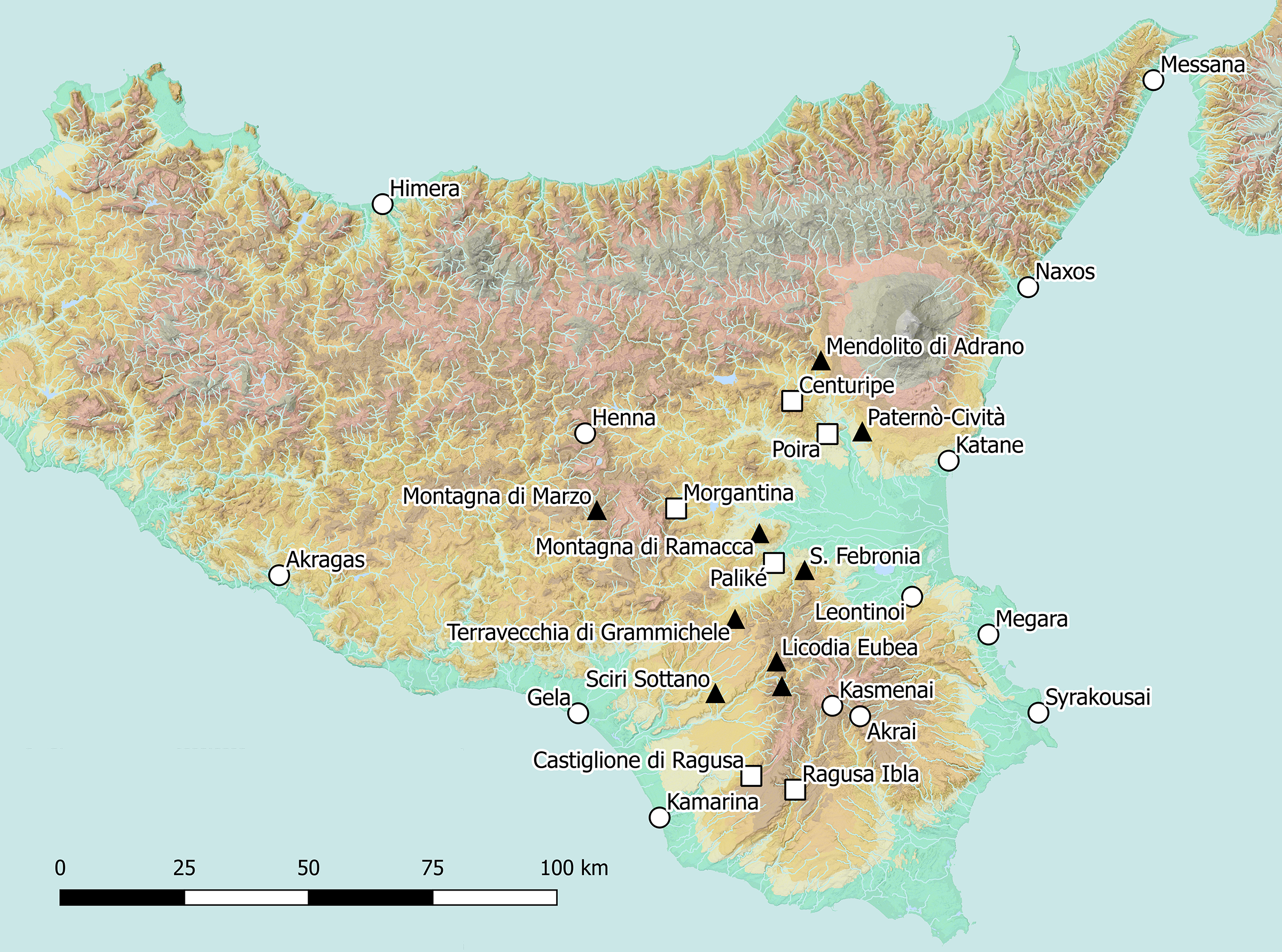

Tuttavia, prima di concludere che vi fossero ragioni identitarie dietro quest’uso epigrafico dovremmo chiederci se questo alpha fosse veramente aberrante nell’epigrafia greca dell’isola al punto da poter essere considerato un marker propriamente siculo. Come ha mostrato chiaramente Olga Tribulato (Tribulato and Mignosa, 2021, 315-318) l’alpha a freccia ricorre nell’epigrafia greca dell’isola, in particolare in diversi testi in metallo (fig. 8), in cui questa variante nacque da un’esigenza prettamente tecnica o divenne una variante associata specificamente ai testi in metallo. La varietà, diffusa in diverse aree dell’isola, potrebbe essere stata adottata dalle botteghe dei centri siculi a contatto con le poleis in cui era utilizzata e poi reiterata come tipo ‘preferito’. La sua diffusione dipenderebbe quindi dalle vie di comunicazione e di scambio dell’area (ibid.: 310-315).
Inoltre, siamo a conoscenza dell’esistenza di un popolo definito ‘siculo’ dai Greci. Tutti i documenti, epigrafici (un famoso e lacunoso trattato tra Atene e alcune poleis siceliote e magnogreche, IG I3 291) e letterari che parlano delle popolazioni dell’area orientale come di un unico popolo sono infatti redatte da Greci e dunque descrivono, piuttosto che una coesione culturale-identitaria storicamente avvenuta, la prospettiva greca su queste genti. Come ha mostrato Amselle, 1993 (e gli studi sulla colonizzazione europea) gli etnonimi non sempre rispecchiano la realtà storica di un luogo quando sono eteronimi, ovvero etnomini dati da altri popoli. Essi hanno invece semplicemente natura ‘performativa’ (ibid.: 17), ovvero sono creati e utilizzati esclusivamente come ‘significati’ (non significanti) per indicare un determinato gruppo sociale da parte di un altro gruppo esterno. Ci troviamo quindi, ancora una volta, davanti a un corto circuito interpretativo nel quale la nostra lettura dei fatti avviene attraverso il racconto dei Greci, a sua volta mediato dalle nostre sovrainterpretazioni identitarie.
Ma c’è di più. La cultura epigrafica dell’isola, quella delle popolazioni locali, nasce alla fine di un processo storico molto più complesso di quanto non siamo riusciti ancora a capire, che è quello della convivenza e dello scambio, dell’adattamento e del riadattamento reciproco avvenuto tra i vari gruppi presenti nell’isola all’indomani dei diversi fenomeni di fondazione. Quando vediamo i Siculi adottare la scrittura, adottare certi tipi iconografici propri dei Greci – con una parola molto discussa e che uso qui provocatoriamente ‘Ellenizzarsi’ – osserviamo solo la fine di un processo, una fase cioè in cui tutti questi popoli a contatto con i Greci hanno sviluppato pratiche e costumi influenzate dai Greci e tendenzialmente tra loro più uniformi.
La risposta a questo gap interpretativo non è rifugiarsi in apparentemente ‘solide’ categorie euristiche come l’Ellenizzazione (e le numerose affini, come l’Acculturazione, l’Ibridazione, il Middle Ground, etc.), o nel riprendere le fonti letterarie alla ricerca di nuove letture. La risposta è cercare di raccontare la storia dei secoli precedenti l’arrivo dei Greci con maggiore profondità storico-sociale e solo dopo addentrarsi nei secoli VIII-V per leggere i fenomeni che li caratterizzano e, quindi, anche le dinamiche di adozione della scrittura e degli habitus epigrafici nella lunga durata. Speriamo di poterlo fare presto!

